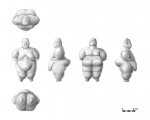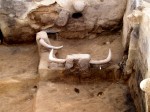 Archaeologists excavating the Neolithic urban settlement of Çatalhöyük in central Turkey have unearthed the figurine of a voluptuous woman in excellent condition. More than 2,000 figurines have been found at Çatalhöyük, but very few of them intact like this one. Several of them were also Mother figures; this is the first one to be found intact and with finely crafted details. It is also unusual in that it was discovered under a platform next to a piece of obsidian where it appears to have been deliberately placed likely for ritual purposes rather than discarded in garbage pits where archaeologists have found many broken statuettes, mostly made of clay. The beautiful Seated Woman of Çatalhöyük, for example, who is herself a zaftig female archetype seated on a throne and captured in the very act of giving birth, was found missing her head and the right hand rest in the shape of a leopard or panther head.
Archaeologists excavating the Neolithic urban settlement of Çatalhöyük in central Turkey have unearthed the figurine of a voluptuous woman in excellent condition. More than 2,000 figurines have been found at Çatalhöyük, but very few of them intact like this one. Several of them were also Mother figures; this is the first one to be found intact and with finely crafted details. It is also unusual in that it was discovered under a platform next to a piece of obsidian where it appears to have been deliberately placed likely for ritual purposes rather than discarded in garbage pits where archaeologists have found many broken statuettes, mostly made of clay. The beautiful Seated Woman of Çatalhöyük, for example, who is herself a zaftig female archetype seated on a throne and captured in the very act of giving birth, was found missing her head and the right hand rest in the shape of a leopard or panther head.
 The figurine is 17 centimeters (6.7 inches) long, 11 centimeters (4.3 inches) wide and weighs one kilo (2.2 pounds), a large, heavy piece for Çatalhöyük. (The Seated Woman is 12 centimeters high.) Her hands and feet are small, markedly out of proportion to her large breasts, belly and buttocks, and her hands are placed under the breasts. She would not have been able to stand vertically on those small feet. The figurine is made of marble, another rarity, and was shaped by extensive polishing of the stone. Details — slanted eyes, a Modigliani-like flat nose, mouth, navel, etc. — were then incised on the figure.
The figurine is 17 centimeters (6.7 inches) long, 11 centimeters (4.3 inches) wide and weighs one kilo (2.2 pounds), a large, heavy piece for Çatalhöyük. (The Seated Woman is 12 centimeters high.) Her hands and feet are small, markedly out of proportion to her large breasts, belly and buttocks, and her hands are placed under the breasts. She would not have been able to stand vertically on those small feet. The figurine is made of marble, another rarity, and was shaped by extensive polishing of the stone. Details — slanted eyes, a Modigliani-like flat nose, mouth, navel, etc. — were then incised on the figure.
 It dates Neolithic occupation of the site, between 7100 and 6000 B.C., so the figurine is at least 8,000 years old. The exaggerated female features — breasts, hips, thighs — of such figures, carved by people for more 40,000 years, have often been interpreted as mother or fertility goddesses, but recent scholarship suggests some of them may represent venerable high status older ladies of the community.
It dates Neolithic occupation of the site, between 7100 and 6000 B.C., so the figurine is at least 8,000 years old. The exaggerated female features — breasts, hips, thighs — of such figures, carved by people for more 40,000 years, have often been interpreted as mother or fertility goddesses, but recent scholarship suggests some of them may represent venerable high status older ladies of the community.
 Çatalhöyük is a fascinating site, founded in a period of transition between highly mobile hunter-gatherers and settled farming communities. No identifiable public buildings have been found thus far, just domestic structures built so close together than people had to use roofs and ladders to move between them. Residents grew a few different kinds of plants and kept cattle — not domesticated yet, mind you — for milk and meat. Large cattle horns were popular decorative features incorporated into the homes. The dead were buried under the houses; there was no dedicated cemetery or burial ground.
Çatalhöyük is a fascinating site, founded in a period of transition between highly mobile hunter-gatherers and settled farming communities. No identifiable public buildings have been found thus far, just domestic structures built so close together than people had to use roofs and ladders to move between them. Residents grew a few different kinds of plants and kept cattle — not domesticated yet, mind you — for milk and meat. Large cattle horns were popular decorative features incorporated into the homes. The dead were buried under the houses; there was no dedicated cemetery or burial ground.
 The Çatalhöyük Research Project has been excavating the settlement since 1993, combining excavation with in situ conservation and curation of artifacts to ensure the long-term preservation of this extraordinarily signficant site. Full details about the newly discovered figurine will be published in the team’s 2016 Archive Report later this year.
The Çatalhöyük Research Project has been excavating the settlement since 1993, combining excavation with in situ conservation and curation of artifacts to ensure the long-term preservation of this extraordinarily signficant site. Full details about the newly discovered figurine will be published in the team’s 2016 Archive Report later this year.
It has always intrigued me why these types of figures do not appear to have hair, or the hair is shaved. I wonder if women shaved their heads at this time, because the sculptor took such care to carve other features such as nose, lips, and eyes. If hair were part of the normal ‘look’ for the time, it would seem hair or a hair covering would be included.
It may have been, by attaching real hair, a very old practice still in use.
Ah! Good point. Hadn’t thought of that.
I surprised you never published this:
http://www.dailysabah.com/history/2016/09/09/2100-year-old-statue-of-cybele-the-anatolian-mother-goddess-unearthed-in-northern-turkey
http://www.dailysabah.com/history/2016/09/09/2100-year-old-statue-of-cybele-the-anatolian-mother-goddess-unearthed-in-northern-turkey
Lice and fleas would have been common. Shaving your head keeps them in check. Ask your Mom, or your Mother Goddess.
Throw some hair and clothes on her and she would look like my cousin’s third wife. Her belly flap often hung out of the bottom of her dress when she was seated. Not a pretty sight.
The fire dept. had to remove the window and use a crane to get her body out of the house when she died. It was a good, old fashioned, double-wide coffin ceremony.
Why is this considered a woman. The features could be male or female from what I can see.
Some Turkish matrons, I am afraid, still look like that today. The statuette itself, however, reminds me of the slightly younger, and by the way actually rather cool, little Neolithic clay statuette referred to as “Sleeping Lady” from the Hypogeum of Ħal-Saflieni in Malta (now in Valetta).
In parts of Africa, there are horrific so-called ‘traditions’ such us ‘Leblouh’ or ‘Gavage’, but I could not say if those things ever played a role here, or if this simply is a case of artistic liberty.
Maybe this is indeed, and equally sad, a ‘foie de gras‘ version of a Nepali ‘Kumari‘. I used to work in liver transplantation and the biggest organ I witnessed was well over 6kg.
Could those very small, apparently round feet have just plugged into a block with two holes for the figurine to stand upright ?
The author of this figurine must have been a great artist of her/his time. The shapes are marvelously balanced. Wow.
I wanted to share this post on facebook but could not find little thingie to do that with. I have in the past. Am I just senile or has this changed?
:ohnoes: Even Neolithic art gets fat-shamed.
She is exquisite. :love:
Good point Karen. Whatever one thinks of today’s beauty standards, the fascinating thing about neolithic sculpture is the almost total consistency in favoring what we would call obesity. Not surprising at all that it would be the standard, given the ever-present possibility of famine, but what is surprising is that the figures look quite recognizable to us. It’s hard to imagine how, in conditions of hunting and gathering or early neolithic farming, anyone could achieve that degree of weight gain, i.e. beauty, so that an artist could reproduce it.
Luckily, there are ‘beauty standards’ in between starved- or eaten to death. Actually, there is nothing to feel fat-ashamed about, as it will help your family to make it over an extremely harsh winter and hence nobody will be sent into the woods.
According to ‘Hansel and Gretel’:
“The witch force-feeds Hansel regularly to fatten him up, but he cleverly offers a bone and the witch feels it, thinking it is his finger. Due to her blindness, she is fooled into thinking Hansel is still too thin to eat. After weeks of this, the witch grows impatient and decides to eat Hansel anyway. The witch prepares the oven for Hansel, but decides to kill Gretel as well”
And here I thought I was the only Barbara. I’ll have to change my sign-on name if there’s going to be more than one.
Your language was very polite to older, fat ladies, and I appreciate it. I suspect that’s how my ancestresses survived those harsh winters, leaving me with my no-longer-adaptive physique.
I actually do go by ‘Barb’, so I changed mine so you wouldn’t feel compelled to change yours. 😉
If my tone was polite, it is because I recognize that older plump ladies such as myself deserve consideration now and then, especially if ancient peoples considered such body types the penultimate sign of ‘plenty’. Although my physique is still somewhat adaptive, it is not nearly as adaptive as one would wish.
As an aside, the more I look at our fleshy idol, I wonder if the figure doesn’t signify a woman who has had children, but wants more. Hence the hands under the breasts to ‘offer’ them and the empty ‘sack’ hoping to be once more the nurturing mound of a developing baby.
So obviously a man, only all of orthodox archaeology could mistake it for a woman.
There is no “exageration” but a very precise depiction of obesity. This is a figure of a woman who was forced-fed.
Your fascinating article is uplifting. Just like the rotund figures at Olmec – I see an Indo-Chinese influence. The figurines could be Sumo wrestlers as they certainly resemble those athletes.